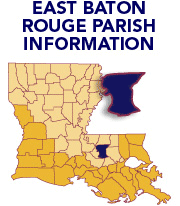East Baton Rouge Parish - Community InvolvementExecutive SummaryThe strategy for community involvement in East Baton Rouge Parish was designed to gain local knowledge and insight within the community and identify the appropriate individuals, groups, organizations and agencies to represent the many aspects of this complex metropolitan area. Initial efforts consisted of a series of introductory meetings with various community leaders and stakeholders. These initial meetings allowed the team to introduce the long-term community recovery program and its outcomes and expectations while seeking information on the issues, needs and recovery projects within the community. After the initial dialog with community leaders, the team formed several recovery strategy focus groups to encourage stakeholder participation and discussion within common segments of the community and to ensure continual feedback throughout the planning process. The strategy has been very effective. Discussions and meetings with community leaders and citizens allowed the team to identify the issues and needs for recovery. Further discussions within focus groups generated key projects for implementation. Public meetings and presentations provided feedback and consensus from the broader community perspective throughout the planning. As a result of these efforts, the community will create and receive a targeted plan for recovery based on local issues and needs. Stakeholders:Below is a list of stakeholder categories with which the parish team interacts on a regular basis:
Local Committee/Task ForceThe East Baton Rouge Parish Long -Term Community Recovery (LTCR) team formed five focus groups centered on the recovery strategy categories of housing, economic development, human services, transportation and infrastructure and environment. The focus groups met on a regular basis with 12 to 20 members representing key agencies and organizations. Each focus group is led by a team member to guide and request input on issues, projects and priorities and to serve as the core stakeholder of the planning process. The focus groups will review the draft information from the parish team. Input EventsFor each of the following, provide a two sentence description covering the type of event, date, number and type of attendees, and results.
Day-to-day interaction with local decision-makers, general publicParish team members attend a variety of meetings at both the local and state level, including Metro Council, Planning Commission, DDD, LRA Task Force meetings, etc. On a daily basis, team members are interacting with a local leaders and discussing issues and projects. Local leadership of implementationSeveral local agencies will be the key stakeholders for the implementation phase. Led by the mayor-president and his staff, the chamber of commerce, BRAF, DDD, will serve as the key stakeholders to ensure implementation. The CAO for the city-parish has already identified the need for a specific staff member within the city-parish dedicated to oversight of the implementation of recovery projects within the community.
|







